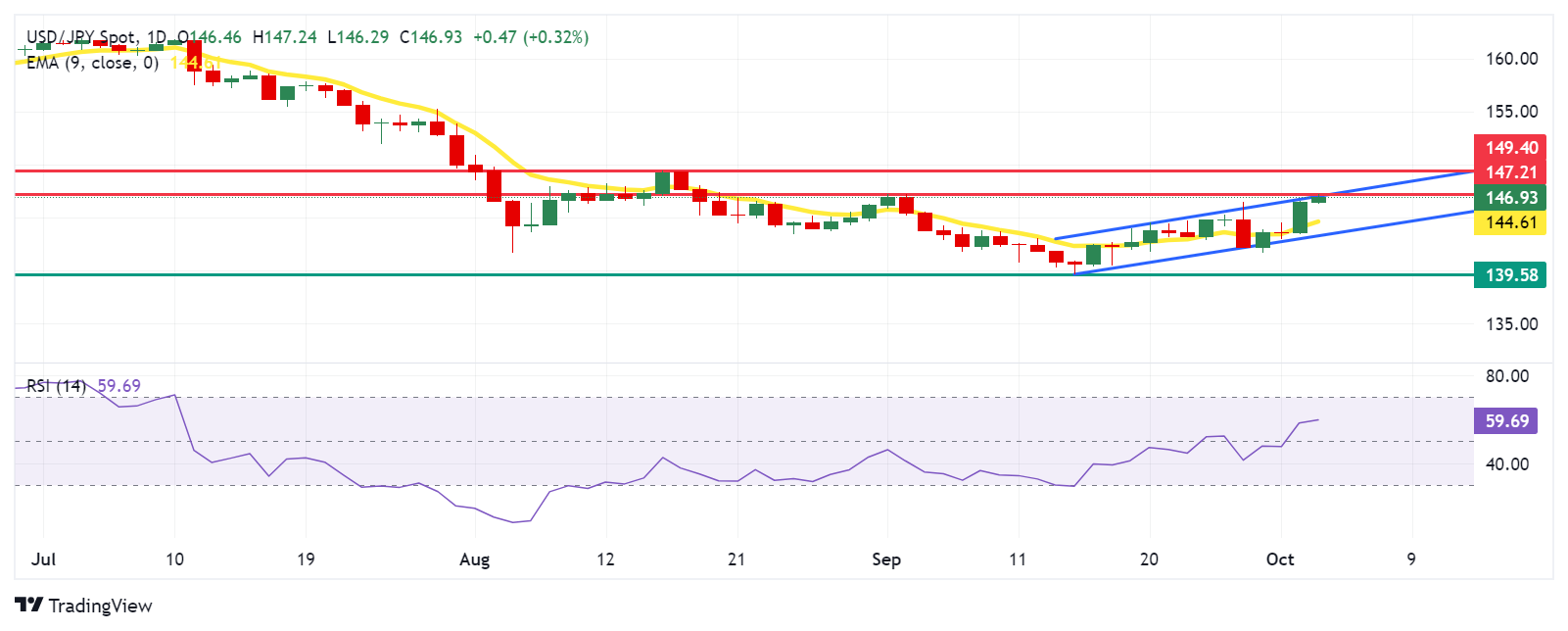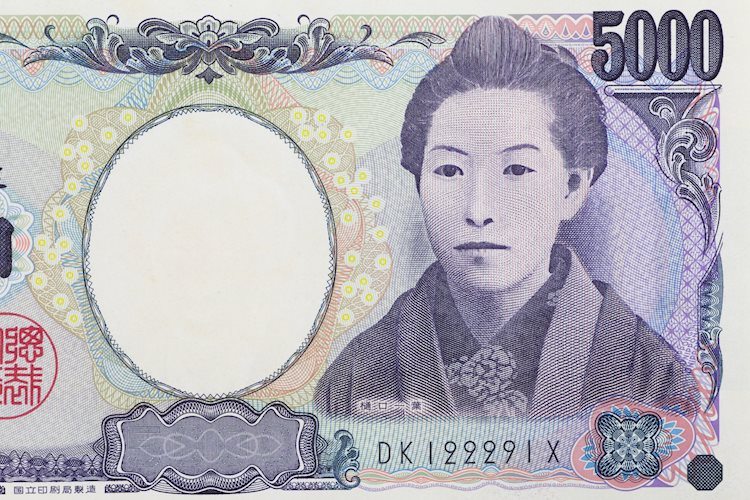Japanese Yen trims losses despite a solid US Dollar, ISM Services PMI awaited
- The Japanese Yen declined as PM Ishiba expressed that the current environment doesn’t require further interest rate increases.
- Japan’s Hayashi clarified that Prime Minister Ishiba did not request any specifics regarding monetary policy from BoJ Governor Ueda.
- Futures suggest less than a 50% chance of the BoJ implementing a 10 basis point rate hike by December.
The Japanese Yen (JPY) faced challenges against the US Dollar (USD) on Thursday following blunt comments on monetary policy from the new Prime Minister (PM) Shigeru Ishiba, who met with Bank of Japan (BoJ) Governor Kazuo Ueda on Wednesday.
Japan’s Prime Minister Ishiba stated, "I do not believe that we are in an environment that would require us to raise interest rates further," according to Reuters. In the previous session, the Japanese Yen fell nearly 2% against the US Dollar (USD), marking its largest drop since February of last year.
Japan’s Chief Cabinet Secretary Yoshimasa Hayashi clarified on Thursday that “Prime Minister Ishiba did not ask BoJ Governor Ueda for any specifics regarding monetary policy during their meeting on Wednesday.” On Wednesday, Japan's Economic Revitalization Minister Ryosei Akazawa stated that PM Ishiba expects the Bank of Japan to conduct thorough economic assessments before considering another interest rate hike.
Futures indicate that there is less than a 50% chance the Bank of Japan will raise rates by 10 basis points by December. Additionally, rates are projected to reach only 0.5% by the end of next year, up from the current 0.25%, per Reuters.
Traders are expected to closely monitor a series of key economic data from the United States (US) scheduled to be released on Thursday, including September's ISM Services Purchasing Managers' Index (PMI) and the weekly Initial Jobless Claims for the previous week.
Daily Digest Market Movers: Japanese Yen depreciates due to dovish sentiment surrounding the BoJ
- The US Dollar receives support from the safe-haven flows amid rising geopolitical tensions in the Middle East. The Israeli Broadcasting Authority (IBA) reported that Israel's security cabinet has decided to issue a strong response to the recent Iranian attack. On Tuesday night, Iran launched over 200 ballistic missiles and drone strikes on Israel.
- The CME FedWatch Tool indicates that markets are assigning a 65.4% probability to a 25 basis point rate cut by the Federal Reserve in November, while the likelihood of a 50-basis-point cut is 34.6%, down from 57.4% a week ago.
- Bank of Japan board member Asahi Noguchi stated that the central bank "must patiently maintain loose monetary conditions." Noguchi indicated that the BoJ will likely make gradual adjustments to the level of monetary support while carefully assessing whether inflation sustainably reaches the 2% target, supported by wage growth.
- Federal Reserve Bank of Richmond President Tom Barkin addressed the Fed's recent rate actions on Wednesday, warning that the fight against inflation may not be over, as risks persist. Barkin noted that the 50 basis point rate cut in September was justified because rates had become "out of sync" with the decline in inflation, while the unemployment rate was near its sustainable level.
- The ADP US Employment Change report showed an increase of 143,000 jobs in September, surpassing the forecasted 120,000 jobs. Additionally, annual pay rose by 4.7% year-over-year. The total number of jobs added in August was revised upward from 99,000 to 103,000.
- US ISM Manufacturing PMI came at 47.2 for September, matching the reading with August's print but came in below the market expectation of 47.5, data showed on Tuesday.
- On Tuesday, BoJ’s Summary of Opinions from September’s Monetary Policy Meeting indicates no immediate plans for additional rate hikes. The central bank intends to maintain its accommodative stance but remains open to adjustments if economic conditions show significant improvement.
- Federal Reserve (Fed) Chairman Jerome Powell said on Monday the central bank is not in a hurry and will lower its benchmark rate ‘over time.’ Fed Chair Powell added that the recent 50 basis point interest rate cut should not be seen as an indication of similarly aggressive future actions, noting that upcoming rate changes are likely to be more modest.
Technical Analysis: USD/JPY tests 147.00, the upper boundary of the ascending channel
USD/JPY trades around 146.80 on Thursday. Analysis of the daily chart indicates that the pair tests to breach above the ascending channel pattern, suggesting a strengthening bullish bias. The 14-day Relative Strength Index (RSI) also moves above the 50 level, confirming the bullish trend's continuation.
The USD/JPY pair encountered resistance near the upper boundary of the ascending channel near the five-week high of 147.21, last reached on September 3. A break above this level could support the pair to test its seven-week high at 149.40.
On the downside, the USD/JPY pair could find support at the nine-day Exponential Moving Average (EMA) around 144.60, followed by the lower boundary of the ascending channel at 143.20. A break below this level could push the USD/JPY pair toward the 139.58 level, marking the lowest since June 2023.
USD/JPY: Daily Chart

Japanese Yen PRICE Today
The table below shows the percentage change of Japanese Yen (JPY) against listed major currencies today. Japanese Yen was the weakest against the US Dollar.
| USD | EUR | GBP | JPY | CAD | AUD | NZD | CHF | |
|---|---|---|---|---|---|---|---|---|
| USD | 0.07% | 1.00% | 0.06% | 0.17% | 0.39% | 0.54% | 0.22% | |
| EUR | -0.07% | 0.93% | -0.03% | 0.07% | 0.32% | 0.46% | 0.15% | |
| GBP | -1.00% | -0.93% | -0.98% | -0.84% | -0.60% | -0.47% | -0.75% | |
| JPY | -0.06% | 0.03% | 0.98% | 0.11% | 0.34% | 0.44% | 0.17% | |
| CAD | -0.17% | -0.07% | 0.84% | -0.11% | 0.23% | 0.38% | 0.07% | |
| AUD | -0.39% | -0.32% | 0.60% | -0.34% | -0.23% | 0.14% | -0.15% | |
| NZD | -0.54% | -0.46% | 0.47% | -0.44% | -0.38% | -0.14% | -0.29% | |
| CHF | -0.22% | -0.15% | 0.75% | -0.17% | -0.07% | 0.15% | 0.29% |
The heat map shows percentage changes of major currencies against each other. The base currency is picked from the left column, while the quote currency is picked from the top row. For example, if you pick the Japanese Yen from the left column and move along the horizontal line to the US Dollar, the percentage change displayed in the box will represent JPY (base)/USD (quote).
Economic Indicator
ISM Services PMI
The Institute for Supply Management (ISM) Services Purchasing Managers Index (PMI), released on a monthly basis, is a leading indicator gauging business activity in the US services sector, which makes up most of the economy. The indicator is obtained from a survey of supply executives across the US based on information they have collected within their respective organizations. Survey responses reflect the change, if any, in the current month compared to the previous month. A reading above 50 indicates that the services economy is generally expanding, a bullish sign for the US Dollar (USD). A reading below 50 signals that services sector activity is generally declining, which is seen as bearish for USD.
Read more.Next release: Thu Oct 03, 2024 14:00
Frequency: Monthly
Consensus: 51.7
Previous: 51.5
Source: Institute for Supply Management
The Institute for Supply Management’s (ISM) Services Purchasing Managers Index (PMI) reveals the current conditions in the US service sector, which has historically been a large GDP contributor. A print above 50 shows expansion in the service sector’s economic activity. Stronger-than-expected readings usually help the USD gather strength against its rivals. In addition to the headline PMI, the Employment Index and the Prices Paid Index numbers are also watched closely by investors as they provide useful insights regarding the state of the labour market and inflation.
Forex News
Keep up with the financial markets, know what's happening and what is affecting the markets with our latest market updates. Analyze market movers, trends and build your trading strategies accordingly.
